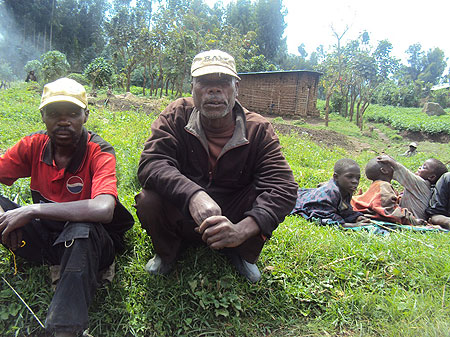The historically marginalized inhabitants of Kabagorozi village said bye, bye to Nyakatsi. The thatched roofs of their tiny houses have been replaced by free iron sheeting. Although happy with the improvement, their house of bamboo and leaves still do not keep the elements out.


The historically marginalized inhabitants of Kabagorozi village said bye, bye to Nyakatsi. The thatched roofs of their tiny houses have been replaced by free iron sheeting. Although happy with the improvement, their house of bamboo and leaves still do not keep the elements out.
The isolated mudugudu (settlement) in Nyange sector lays in the shadow the idyllic forested Virunga Mountains. Rain and cold dominate the weather in the area.
"We don’t want to be called ‘abahejwe inyuma na mateka’ (historically marginalized) anymore,” loudly states Gregoir Nzigore. "We are no longer being discriminated against by others. We wear clothes, have shoes and can sit and share with the rest of the community.”
His wife, Dorotia Mukarurema, disagrees with him and interrupts. "Our biggest problems are the lack of land for cultivation, and school uniforms for the children. We survive on hand-outs as manual laborers.”
She throws her husband a challenging look. He answers with a grin.
There are a large number or children in the village while it’s a normal weekday morning.
"We don’t have school uniforms,” explains 13-year-old Claude Dusengimana, who dropped out in Primary Three.
His father, Apolo Sasita, 64 years, adds that not only children lack clothing. "This is my wife, Beate Mbayehe. She has to go and visit a friend of ours who is admitted in Kinigi Health Centre. My wife had to borrow this dress from another woman”.
More than a dozen historically marginalized families, originally known as Abatwa, live in Kabagorozi. Their houses stand close to the slopes of the misty Sabyinyo and Gahinga volcanoes, which separate the human inhabited area from the home of the rare Mountain Gorillas.
"The biggest part of my life, I was a hunter in the forests. I learnt how to lay snares when I was 12 years old. For 30 years I lived as a hunter in the forests,” recalls Sasita while pointing his stick to the tree cover on the slopes of the mountains. He slowly shakes his head and falls silent.
The historically marginalized appreciate that they now have health insurance, free education for their children and are no longer discriminated in society. But they are disappointed that they have not been compensated for losing their traditional hunting grounds in the Volcanoes Park, now the shelter for the endangered Mountain Gorillas.
"Virunga was our source of survival. We depended on meat and honey we found there. We sold meat to others to get money,” explains Ngendahimana Yaduri. "What can I do? There is no job for us, the Twa. Am I expected to go asking for a job from door to door?’’
There is a reduction in cases of conflict between men and wildlife since the Volcanoes Park was turned into a protected area for animals, accounts Orest Ndayisaba, in charge of Community Based Tourism in the park.
"The park involves historical marginalized people into activities such as pottery clubs, carrying luggage for tourists or help with the maintenance of the park wall,” tells Ndayisaba.
But the inhabitants of Kabagorozi are not satisfied with their life style and blame their plight on the lack of land for cultivation. However, local authorities counter that a number of the historically marginalized people sold their ancestral plots as well as the iron sheets for their roofs.
Pelagie Mukanyandwi , the Executive Secretary of Nyange sector, tells that the 63 historically marginalized families in his region are incorporated amongst the other inhabitant. He acknowledges that circumstances in the area are not always easy for the population in general.
"In the volcanic zone are no soils to use for covering the walls of houses. Another issue is the lack of land for cultivation.”
The end of the Nyakatsi era improved lives in Kabagorozi. The historical marginalized inhabitants hope that their lives will develop from now on with greater speed.


